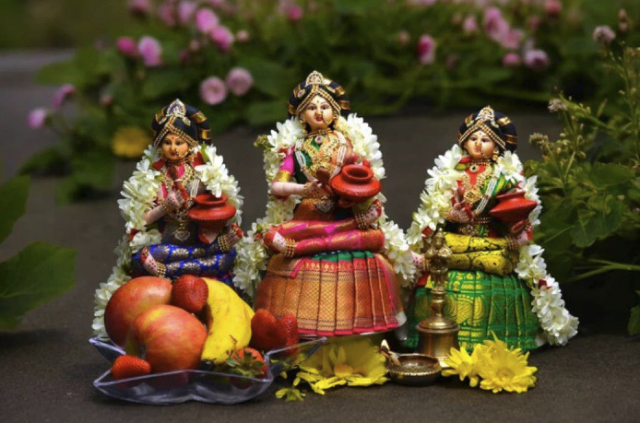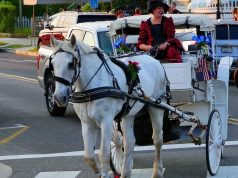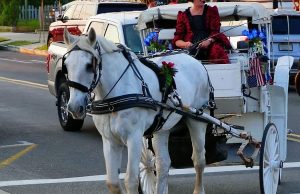Varalakshmi Vratham is a revered Hindu festival celebrated with great devotion and fervor, primarily by married women seeking the blessings of Goddess Varalakshmi for the well-being and prosperity of their families.
This auspicious occasion is marked by the performance of elaborate rituals and the offering of prayers to the goddess, accompanied by the use of traditional Pooja Samagri, or items essential for the ceremony.
In this article, we will explore the timeless elegance of traditional Varalakshmi Pooja Samagri and delve into the significance of each item used in the ritual.
Idol or Picture of Goddess Varalakshmi
Central to the Varalakshmi Vratham ceremony is the worship of Goddess Varalakshmi, the benevolent deity who grants boons and blessings to her devotees.
The idol or picture of Goddess Varalakshmi serves as the focal point of the Puja, representing her divine presence among the worshippers. The idol is typically adorned with traditional attire, jewelry, and floral garlands, symbolizing her divine beauty and grace.
Devotees offer prayers, perform rituals, and chant hymns to invoke the blessings of Goddess Varalakshmi, seeking her divine protection, prosperity, and well-being for themselves and their families. Gathering the appropriate Varalakshmi Pooja samagri is essential to ensure all rituals are performed correctly and to honor the deity properly.
The Kalash
At the heart of Varalakshmi Vratham lies the Kalash, a sacred pot or vessel representing abundance, fertility, and prosperity. The Kalash is traditionally made of copper, silver, or brass and is adorned with intricate designs or motifs symbolizing auspiciousness.
It is filled with water, symbolizing the primordial ocean of creation, and embellished with mango leaves, coconut, turmeric, and vermilion at its mouth, signifying auspiciousness and purity. The Kalash is revered as the dwelling place of Goddess Lakshmi, and its presence in the Puja signifies the invocation of her divine blessings upon the household.
Puja Thali
The Puja Thali, or tray, is an essential component of Varalakshmi Pooja, serving as the vessel for holding various offerings and items used during the ceremony. The Thali is typically made of metal such as brass or silver, and is adorned with intricate designs or engravings symbolizing auspiciousness and prosperity.
It contains a variety of items, including incense sticks, flowers, fruits, sweets, sacred water, vermilion, turmeric, and betel leaves, each representing a specific aspect of the Puja ritual. The Puja Thali symbolizes the confluence of offerings made to the divine, signifying devotion, gratitude, and reverence towards Goddess Varalakshmi.
Sweets and Fruits
Sweets and fruits hold a significant place in Varalakshmi Pooja as offerings made to the goddess as a symbol of abundance, prosperity, and sustenance. Devotees offer a variety of sweets, such as laddoos, modaks, and kheer as well as seasonal fruits including bananas, mangoes, and coconuts to the deity as a gesture of gratitude and reverence.
These offerings are believed to please Goddess Varalakshmi and attract her divine blessings, ensuring prosperity, fertility, and well-being for the family.
Incense Sticks and Dhoop
Incense sticks and dhoop (fragrant resin) are integral to Varalakshmi Pooja as they serve to purify the air, create a serene ambiance, and invoke the divine presence of Goddess Varalakshmi.
Devotees light incense sticks and dhoop and offer them to the deity while chanting prayers and hymns, symbolizing the offering of fragrant smoke to the divine. The sweet fragrance of incense and dhoop is believed to please the goddess and attract her divine grace and blessings upon the household.
Flowers
Flowers hold profound symbolism in Hindu rituals and ceremonies, representing purity, beauty, and devotion. In Varalakshmi Pooja, devotees offer fresh flowers, such as jasmine, roses, and marigolds, to the goddess as a gesture of reverence and devotion.
Flowers are used to decorate the Puja altar, adorn the idol or picture of Goddess Varalakshmi, and create intricate floral arrangements, symbolizing the auspiciousness and sanctity of the occasion. The fragrance and beauty of flowers elevate the ambiance of the Puja, creating a serene and sacred atmosphere conducive to worship and meditation.
Sandalwood Paste and Kumkum
Sandalwood paste and kumkum (vermilion) are sacred substances used in Hindu rituals and ceremonies for their auspicious properties. Devotees apply sandalwood paste and kumkum on the forehead of the idol or picture of Goddess Varalakshmi as a mark of respect and devotion.
Sandalwood paste is believed to have cooling properties and is associated with purity and spiritual enlightenment, while kumkum is symbolic of auspiciousness, prosperity, and marital bliss.
Rice, Turmeric, and Betel Leaves
Rice, turmeric, and betel leaves are symbolic offerings made to Goddess Varalakshmi during the Puja ceremony, representing fertility, prosperity, and auspiciousness. Devotees offer raw rice and turmeric grains to the deity as a symbol of abundance and prosperity, seeking her blessings for wealth and well-being.
Betel leaves known for their medicinal properties are offered to the goddess as a sign of respect and devotion. These symbolic offerings are believed to please Goddess Varalakshmi and attract her divine blessings, ensuring the prosperity and happiness of the devotees and their families.
Coconut, Banana, and Mango Leaves
Coconut, banana, and mango leaves hold special significance in Hindu rituals and ceremonies, symbolizing purity, auspiciousness, and fertility. Devotees offer these natural elements to Goddess Varalakshmi as sacred offerings, seeking her divine blessings for abundance and prosperity.
Coconut represents purity and fertility, while banana leaves symbolize auspiciousness and protection. Mango leaves are associated with prosperity and growth. These sacred offerings are believed to please the goddess and attract her benevolent blessings, ensuring the fulfillment of devotees’ wishes and desires.
Camphor and Ghee
Camphor and ghee (clarified butter) are essential items used during Aarti, a ritualistic offering of light to the deity. Devotees light camphor and ghee lamps and offer them to Goddess Varalakshmi while chanting hymns and prayers, symbolizing the illumination of her divine presence.
The flickering flame of the lamps represents the eternal light of knowledge and wisdom, dispelling darkness and ignorance. The fragrance of camphor and ghee is believed to purify the atmosphere and attract the blessings of the goddess, ensuring spiritual enlightenment and prosperity for the devotees.
Prasad
Prasad, or sacred food offerings are an integral part of Varalakshmi Pooja, symbolizing the blessings of Goddess Varalakshmi in edible form. Devotees prepare a variety of dishes including sweets, fruits, and cooked food, as offerings to the goddess.
These offerings are first offered to the deity during the Puja ceremony and then distributed as Prasad to the devotees, symbolizing the sharing of divine blessings and grace. Consuming Prasad is considered auspicious and is believed to bestow health, prosperity, and spiritual well-being upon the recipients.
Conclusion
The traditional Varalakshmi Pooja Samagri embodies timeless elegance and profound symbolism, reflecting the rich cultural heritage and spiritual significance of Hindu rituals and ceremonies. Each item used in the Puja holds deep meaning and significance, representing divine attributes, auspiciousness, and prosperity.
From the sacred Kalash symbolizing abundance to the fragrant flowers evoking devotion, every element of the Pooja Samagri plays a vital role in invoking the blessings of Goddess Varalakshmi and fostering spiritual fulfillment.







